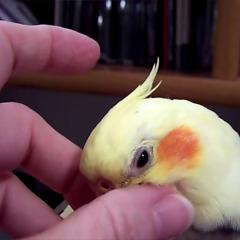Why the parrot itches to blood. Why do parrots pluck their feathers
Many owners of parrots are faced with such a problem, as the bird's self-tallowing its own feathers. There are several reasons why a parrot plucks feathers for itself.
Causes of self-priming in parrots
Sometimes the reason for plucking feathers by a parrot can be trivial stress or keeping it in poor conditions. For example, Corella parrots may pluck feathers due to their content in cramped cages. And wavy parrots, by their very nature being very sociable birds, do not tolerate loneliness and lack of attention to their person. This not only causes them stress, manifested, including in plucking feathers, but can even lead to the death of the feathered. What to do in cases of plucking feathers parrot? The best thing to contact a veterinarian specializing in the treatment of birds. If the cause of samooschipyvaniya in any, he will recommend a specific treatment. Otherwise
Pests can get to the bird from non-disinfected new bird accessories or cages, domestic animals, street birds, things brought from the street, twigs from trees, objects or products purchased in the store.
Possible changes in the condition of the bird
![]()
If you do not pay attention to such changes in the behavior of the Corella, he will gradually begin to weaken. First, the parrot loses its appetite, which is why it quickly loses weight. Sleep mode - the bird is experiencing constant flour and not getting enough sleep. And depending on the time of year, she should sleep ten to fourteen hours a day. This leads to constant lack of sleep and lack of coordination of movements. A weakened and drowsy bird may fall from perches.
The appearance of Coral leaves much to be desired - disheveled, deformed, lost their usual shine, feathers, bald combed skin, growths and detachments on the beak, legs, cloaca and around the eyes. In a state of neglect, the paws may be denied or some serious illness begins, for example, cachexia - an extreme depletion of the avian organism. Without timely help death comes.
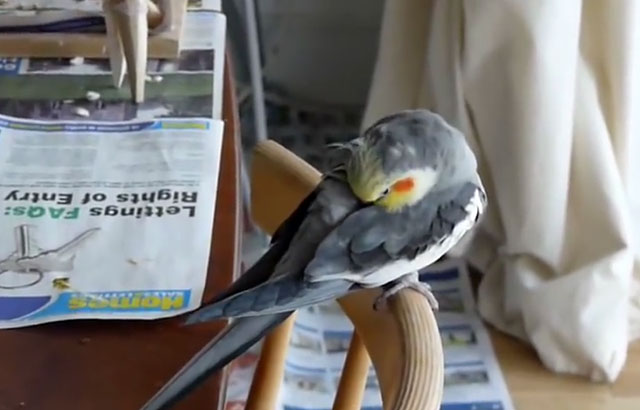
Pliers
Main types
There are several types of ticks that choose the body of a parrot to live:
- red bird ticks (gamazovye);
- fluffy eats;
- scabies mites (cnemidocoptosis).
Consider separately each type of pest.
Red bird tongs
Due to the red color, gamasid mites are easy to see with the naked eye. If you notice a cluster of reddish points on the corell or inside the cell, you should know - this is them. The main sources of infection: sand, earth, poor quality, especially by weight, street birds.

Fluffy eats
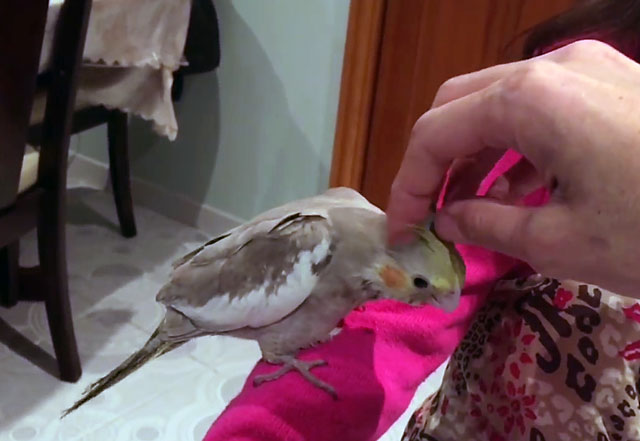
These mites get to the parrot through tree branches, wooden bird accessories. A pet may be infected by poor-quality grain mixture or sick birds. The fact that Corella is infected, can tell his nervous condition, lack of appetite, untidy appearance, permanent carding of the affected areas.
Knemidokoptoz
The itch mite is very dangerous to the health of the parrot, as it affects its horny layers. It can appear in a pet in the same ways as other ticks.
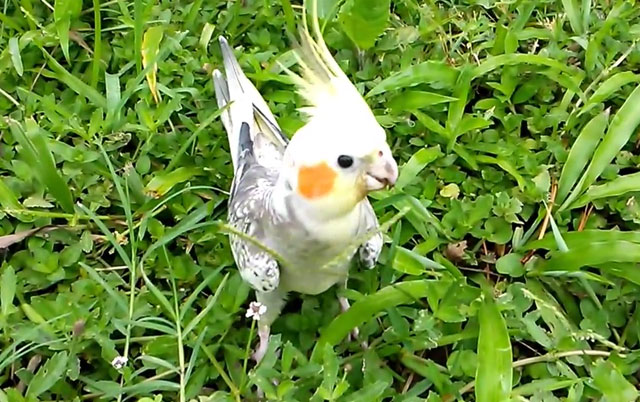
As a result, the disease passes into a critical stage: the pet's completely bald body becomes covered with growths, sore joints are visible, paws fail. At this stage, the infected bird is almost impossible to cure. Therefore, it is better not to start the disease, otherwise the death of the parrot is inevitable.
Fleas
Fleas come to the pet in the same way as ticks. However, due to the ability to jump a distance of about thirty centimeters, other ways are available for them: attics, basements, ventilation shafts.
For fleas, the body of the Corella is just food, so they are not on it for long. In general, the life of a flea is two weeks. But even during such a period of time insects have time to lay a large number of eggs, mainly near the bases of feathers.
From fleas a lot of harm, because they carry various infections and worms eggs. Their bites can cause skin irritation. This leads to severe bleeding due to the constant scratching of the bites in the bird. A weakened immune system makes a pet nervous, depriving him of sleep.
You can wash the cage and equipment with a Disinsectal solution. After applying it, rinse thoroughly all items with clean, warm water and dry well.
Be sure to throw out all the grain mixture that is in the house. Get a new feed. It is better if it is sealed. Don't buy by weight - it is in these grains that insect larvae are most often found. Do not save on pet's health!
Treatment methods
If you notice early signs of infection, which we wrote about above, and Corella does not yet have severe damage to feathers and skin, you can use an ointment called “Birch tar” for treatment. Enough to smear the affected areas for three to four days.
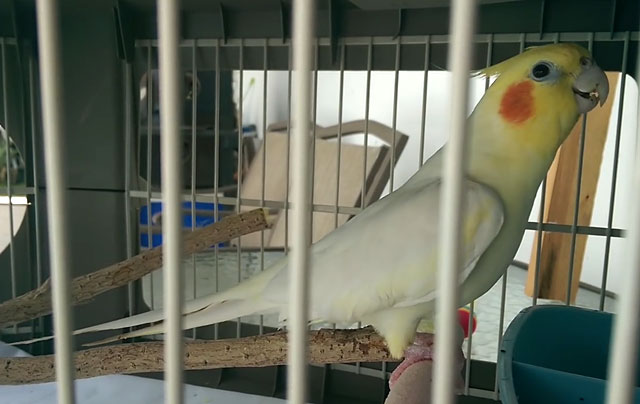
In more advanced cases, to get rid of pests, you can use drugs such as Frontline, Insectal, and Ivomek according to the attached instructions.
From scabby mites, novertin or aversectin ointment helps well - every three to four days until the parrot is completely cured. And from fleas - flea shampoo.
Any drug must be applied with a cotton swab. All movements must be careful to avoid getting the medicine in the pet's eyes and nostrils. Shampoo is also used with care - they soap everything except the head of the bird and carefully wash it off with warm water.
Why else can the bird itch
Corella can itch for natural reasons. First, for hygienic purposes. Cleansing their plumage from dirt and dust, they are exempt from excess weight, preventing free movement. Also cleaning feathers helps parrots pass the time.
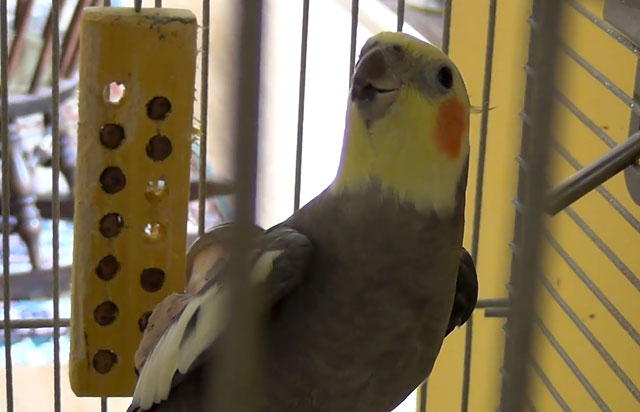
Sometimes the parrot itches because it has skin problems or plumage. There are several reasons for this phenomenon:
- bad conditions of detention: dry air in the room where the bird lives, lack of sunbathing or artificial lighting, unsanitary conditions in the cage;
- stressful situations: a sudden change of scenery, loneliness, loud noise, hormonal disruptions, fright;
- dermal dermatitis - inflammation of the skin.

If nothing helps the bird and it continues to itch, immediately show it to the veterinarian. Perhaps the parrot is seriously ill. After a thorough examination and delivery of bird tests, the doctor will determine the true reason for this behavior of the pet and prescribe the appropriate treatment.
When an inexperienced poultry farmer for the first time sees his feathered pet torturing himself, he becomes perplexed and terrified. The bird pulls out feathers, and blood runs along the bars of the cage. This picture makes you run away from home. So say the owners on the forums. What happens to the feathered pet? What is the reason for this behavior? How to help the parrot to bounce back?
And the diet is wrong ...
Chaotic bird feeding is one of the most common causes of pruritus. Many owners make an irreparable mistake, allowing the bird to eat up the leftovers from the master's table, allowing them to eat pasta, meatballs, peck pancakes, roasted seeds, and raw meat. Parrots get used to such food quickly. The owners are comfortable, because you do not need to spend money on special food, you can eat with the bird. But such happiness ends quickly. One day, the bird begins to pull out its own feathers, and at such a pace that soon they will remain only on the head and neck. There is simply impossible to reach the beak. It is necessary to understand that food, which is suitable for our organism, is a taboo for birds. And if you let the parrot constantly eat from the master's table, then his metabolism is disturbed, his kidneys and liver are affected. The feathered pet is severely itchy. It often itches, and therefore pulls out feathers. Also, females can do this during the feeding of chicks, when there is not enough protein and minerals in their diet.
And the stress birds are typical
Emotional experiences can also cause the bird to pluck its own feathers. Stress in parrots can occur as a result of moving into a smaller cage, after the death of a partner or separation from him, a change of owner. Sometimes the causes of emotional distress are physical punishment. Some owners beat the birds for mischief, unwillingness to learn to speak. And stress can be the result of keeping two birds of the same sex in one cage. One will dominate, the second will be weaker. She just may experience a stressful state with plucking feathers. Cats and dogs can also scare the parrot. If a cat tries to get a bird out of its cage, then it experiences a strong shock.
Yes, and life in complete solitude, when the owner rarely communicates with the parrot, can also lead to stressful states, because in nature these birds are gregarious. Loneliness is not peculiar to them. People who leave their birds alone for a whole day should not get a Jacoot parrot. They are very sensitive to loneliness and more often than others experience emotional discomfort about this.
For the growth of feathers in birds, the thyroid gland is responsible. It produces hormones that affect the oxidative processes in tissues, metabolism, and heat regulation. During molting in birds, due to this organ, the level of oxidative processes in tissues increases. The blood contains a high concentration of nitrogen and sulfur, which are necessary for the development of feathers. When the parrot itself deprives them, the thyroid gland, as during natural molting, begins to work hard. Feathers grow back, but the parrot in a state of stress again remains without them. The thyroid gland again intensively synthesizes hormones. The bird again plucks the plumage and as a result, the main organ of the endocrine system is depleted. He stops producing hormones. Then the bird can be completely bald. On her body will remain only the large feathers of the wings, primary and tail lights on the tail. That is why you need to carefully monitor the condition of the birds and create emotional comfort for them.
“Where the forest is like paradise and where there are flowers all year round.
The parrot lives - birds of marvelous beauty.
Shine with all inflorescences of colors, with each feather bloom.
How many birds of fairy tales know, how many songs they take care of! ”
E. Frantsuzova
Parrots, funny domestic birds have a luxurious plumage - the pride of the owners and the birds themselves. How much joy and fun minutes they carry the owner! And so much excitement causes situations when beautiful feathers are lost! Talking birds are inclined to engage in self-ingestion.
You can not watch without tears, as a gorgeous bird turns into a miserable likeness of a naked chicken carcass. What's happening? Why does a parrot pull feathers? Let's figure it out.
Preliminary inspection
To inspect the pet take the parrot on his hands. If the bird is already accustomed and accustomed to the situation - it will be easy to do. But for another wild parrot inspection can cause stress. In this case, act gently, not forgetting to talk to your pet in a soothing voice.
Behavior.Healthy bird active and agile, cheerfully responsive to sounds. But when the parrot is crouched, sits on the perch for a long time, constantly drowsy - this is not normal. Especially if the pet refuses to eat and does not want to communicate. This behavior indicates the development of the disease.
Completeness. Pay attention to the fatness of the bird! A sick parrot loses up to 1/3 of body weight (a bird can lose weight in 20-24 hours). Fatness is checked for the development of the pectoral muscles (in a healthy parrot, it is elastic and round). But in case of eating disorders, especially in case of cachexia (exhaustion), the keel bone easily feels the pointed edge.
A keel bone (keel) is a longitudinal lower bone that has a cartilage. It is located in the lower chest region.
Feathers. A healthy parrot feather cover is clean, smooth and smooth. If the parrot has become dirty and disheveled - pick it up and carefully inspect:
Leather.To view and evaluate the skin of the bird, gently move the feathers apart and examine the skin. In a healthy feathered epidermis, light pink. Yellow color indicates obesity or liver disease.
A dangerous situation is dehydration of the pet. To check this, slightly raise the eyelid skin (if dehydration is present - the raised skin remains wrinkled and does not return to its original state for a while).
Ears.Carefully inspect the parrot's ear openings to detect excessive secretion or foreign bodies. To view the ears, carefully lift the bird feathers on the head and inspect the ear holes.
Eyes. Healthy eyes are clear, with a clean cornea. If diseases develop in the birds, the eyes react as follows:
- The third lid falls out.
- There is lacrimation.
- Conjunctiva reddens and swells.
Blanching of the conjunctiva tells us that the parrot begins to have anemia. To test the assumption, gently touch the eye mucosa. With anemia, the eye membranes are soft and supple. But consider the age of the bird - in older individuals, the conjunctiva pales.
Nose. When the parrot develops inflammatory diseases of the respiratory organs, a serous fluid flows out of the nozzle. If the discharge is cloudy, there is too much dust in the surrounding air.
Beak. In a healthy bird, the horny surface of the beak is smooth and shiny, without growths, tumors and abscesses.
Mouth. To inspect the oral cavity, gently tap the pet on the beak. On examination, pay attention to the condition of the tongue and the color of the mucous membranes. It is also necessary to examine the goiter area (hold the goiter area with your index finger and thumb and feel it).
If the contents of the goiter are frothy, white or the consistency of the goiter is solid - this indicates inflammation. The bird takes dirty water and food that is stained in the litter.
AnusLook carefully at the butt area (first gently blot the cloaca with a cotton pad). In a healthy parrot, the area on the priest has no swelling and redness. Otherwise, the bird inflammatory processes occur.
Paws. Paws of a parrot inspect at the end of a preventive measure. Claw deformation says illiterate content and a small number of perches-perches. Skin covered with horny scales - a sign of the defeat of poultry with itch mites.
If there is a suspicion that the pet is ill, the parrot will immediately quarantine the rest of its relatives in a quarantine box. Sick birds feed dry / soft food or sprouted millet. Exclude fruits, greens from the diet. And hurry to the vet!
Causes of samochasya
The reasons provoking the birds to be engaged in tearing out at themselves (and partners) feathers are numerous. This behavior is observed in diseases, poor conditions of detention and mental disorder of the birds. Consider each reason in more detail.
Diseases
Knemidokoptoz threats to man does not carry. The scabby mite, falling on human skin, dies in 1-2 days.
SymptomsThe disease goes through four stages of development:
- Initial. The cunning of the disease is that symptoms are not immediately apparent. At the initial stage, it is impossible to recognize the disease. Knemidokoptoz appears as soon as ticks reach the adult stage (it takes 3-4 months).
- Easy On the paws and the area of the mandible (articulation), growths similar to calcareous heaps are formed. The skin flakes, itches, begins its detachment. Sick parrot gnaws paws and pulls out feathers, trying to scratch the itchy skin.
- Average. Scabies is already pronounced. Mite occupies almost all the body of the unfortunate bird. The parrot eats badly due to the deformation of the beak, violently plucking feathers to the blood. The behavior of the bird is lethargic, lifeless.
- Heavy The poor bird completely loses the feather cover. The skin and beak are covered with coarse growths. Inflammation of the joints begins (if the parrot loses its limbs, it dies).
 Causes of illness. Where does the terrible creation of home-living parrots come from? Birds catch ticks in the pet store because of the fall of immunity. The mite enters the cell together with poor-quality, dirty food and as a result of living in unsanitary conditions.
Causes of illness. Where does the terrible creation of home-living parrots come from? Birds catch ticks in the pet store because of the fall of immunity. The mite enters the cell together with poor-quality, dirty food and as a result of living in unsanitary conditions.
The feathers struck by puff-eaters become full of holes, their tips are deformed, twisted. Birds inflame eyes, feathers fall out completely on the back. Newborn chicks die.
Lungs are visible to the naked eye - they look like dark, moving rods. Bird lice instantly infect their neighbors in the cage, and the parrots begin to pluck feathers from each other.
Symptoms You can find out that your pet is sick by the following criteria:
- Characteristic spots appear on the face of a parrot, beak, legs. They are covered with gray scales and very itchy.
- Pet, getting rid of the itch, combs the skin with his beak, paws, tearing out feathers.
- In the craw, the bird appears white cheesy plaque. These secretions stain the plumage around the head.
- In a sick bird, appetite decreases, gastrointestinal disorders (diarrhea) begin. The sick pet is sluggish, weak, breathing hard.
The reason for self-salting is illiterate care.
Parrot - a creature capricious and wayward. The pet is demanded by love, care of the person and good conditions of the maintenance. Good content means:
- Proper illumination (daylight feathered is 15-16 hours).
- Location of the cell (away from drafts, windows, heating devices).
- The frequency of bathing (regularly, especially in hot weather, after the procedure, the bath should be removed, and the wet surface of the cell should be wiped dry).
- Clean air (near birds can not smoke, use aerosol means).
- Humidity and temperature (the best for the life of the pet will be the air temperature + 20-25 ⁰ C with a humidity of 70-80).
Particular attention should be paid to the owners of clean air and regular bathing birds. Dirt feathers, inhalation of dust provoke the development of samosychpyvaniya. The bird, striving for cleanliness, pulls out dirty feathers.
Poor sleep and instability of the daytime lead to self-salting. With good lighting in birds, the calcium metabolism normalizes, the feathers become strong and healthy.
Cell.Some, especially sensitive birds begin to pull out feathers, living in a round cage. Many parrots are wary of strangers and strangers and tend to hide in the injection of the home. If there are no corners, a frustrated, frightened pet begins to tear up feathers. 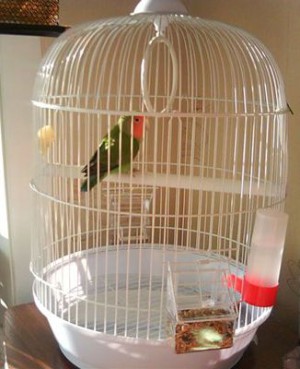
Poisoning.One of the causes of samooschipyvaniya - metal poisoning. What is a cage made of? In the production of cheap homes and accessories use tin, zinc, lead. Parrot, gnawing up the bars of the cage, is poisoned. Due to the poisoning, the owner should only water the pet with bottled water (it is forbidden to give water from under the tap!).
Nutrition. Many birds pluck feathers because of allergies. Allergic reactions cause improper feed. Owners should very carefully enter into the diet new food, looking at the behavior of birds, and abandon the use of mineral stones with dyes.
The bird pulls feathers due to the lack of certain substances in the body (in this case, the plucked feather has a stem filled with blood). This is due to the lack of the amino acid arginine in the body. Most arginine is found in:
- Rapeseed
- Niger.
- Oatmeal.
- Canary seed.
The self-help of talkative pets begins because of an attempt to independently treat a sick bird (the wrong choice of medicine, failure to comply with the norm). Ownership arrogance leads to allergic reactions, poisoning and death of the bird.
Natural causes
Parrots regularly moult, feather cover changes and pets "help" themselves quickly get rid of feathers. With the end of the molting, self-salting stops. The pet itself does not show any signs of illness or behavior disorders - it is cheerful and active.
But when stress falls on the unfortunate parrot, things are much worse. Being under the influence of emotional overload, melancholy, despondency, the self-salting of a pet reaches such an extent that there is not a single feather on the body. What triggers stress?
- Loneliness, lack of fun and toys.
- The climate in the family (frequent quarrels, screams, abuse by people).
In stress, parrots more often drives their own owner. Accustomed to waking up with the first rays of the sun, talkative birds begin to make noise. A sleepy person, hoping to sleep a little more, covers the cell with a tissue, provoking a stressful situation in the feathered one.
Hungry birds sitting in the dark and loneliness of boredom, sadness begin to pull out their feathers.
What to advise? Love and respect the feathered pets, make them a pair (female or male), regularly let fly around the apartment and never scream at them.
According to the observations made by leading ornithologists, parrots of the following breeds are most susceptible to self-salting:
- Cockatoo.
- Aratings.
- Monkey parrots.
- Gray-eyed parrots.
- Representatives of the macaw family.
- Representatives of the type of lovebirds.
- Eclectuses (parrots of noble blood).
- Jaco (African gray and red-tailed parrots).
- Representatives of the group of ringed parrots (kiserelnye, slizogolovy and Alexandria).
But Amadin, Amazons, budgerigars, Corella such behavior disorder overtakes rarely. Self-help is a serious disorder that adversely affects the health and mental state of the parrot.
The work of the thyroid gland and endocrine glands suffers. The healthy growth of feathers depends on the functioning of the thyroid gland. A pet, tearing out feathers, makes the thyroid gland work hard. Over time, her strength and energy reserves are depleted.
A weakened thyroid stops producing the hormones necessary for the development and health of the bird, which leads to serious illnesses and mental disorders. This condition should be immediately treated and corrected!
What to do?
Rid the pet of depression and loneliness. Get a friend / girlfriend parrot, but do not forget that the new bird needs quarantine mode. Parrots are creatures that adore imitation. If there is a sick bird in the dwelling, engaged in pulling out feathers, looking at it, and healthy relatives will start self-salting.
Review and improve the content, the diet of the bird. Constantly offer your pet new good quality food - variety is important in food!
Do not pay attention to the indignant cries of capricious feathered! Let's just "correct" food and do not remove the food, even if the parrot is on a hunger strike.
Sometimes with the education of parrots requires patience and endurance. Sometimes it takes months to train a pet for healthy food. In this the man is obliged to win, not the pet! Eliminate from the diet walnuts, oilseeds. The bird should regularly eat beets, carrots, salad (this food stimulates the thyroid, and saturate the body with iodine).
Iodine is an essential trace element for the growth and strength of feathers. If the bird itches, turn on vitamin B15 and calcium pangamat (half a dragee). For the health of the nervous system is useful tincture of valerian, Eleutherococcus, pollen. Tinctures mixed with honey, sugar and give a pet.
Provide your favorite bird with a bath, putting a container with warm water in the cage every day. In winter, additionally conduct sessions of UV irradiation. In severe cases, when samooshchipyvanie progresses, wearing a special collar helps. You can do it yourself:
- Take a dense, elastic material (better plastic).
- Cut a circle out of it (its diameter depends on its size). Calculate its size so that the birds could not reach the calf with its beak.
- In the center of the circle, make another hole, equal in diameter to the neck of the parrot.
- Clean the edges with sandpaper - they should be smooth so as not to injure the delicate skin.
- Slip the bird over and fasten the edges of the product.
Pet collar will have to wear for 1-2 months. If the bad habit has returned, and self-salting has resumed, the pet will have to carry the collar for another six months. Do not forget to move the trough and the feeder so that the parrot in the collar can reach them.
With joint efforts, round-the-clock care and attention, the owner will be able to help the poor fellow-parrot to get rid of the disfiguring bad habit and return to the bird a luxurious, beautiful plumage!
news
Aydavet veterinarian opened in Minsk
More and more veterinary clinics appear in Belarus. Recently, in the south-west of Minsk, the veterinary clinic Aydavet opened its doors.
Vet Clinic Vet City moved to a new building
At the end of June, the transfer of the Vet City clinic in Minsk to the 4th Koltsov Lane, 51 was completed.We Vkontakte
Articles
Why do you need to play with the dog
The game lays the foundation for mutual understanding between a man and a dog, contributes to the establishment of trusting relationships and allows developing joint habits. During the game, the dog moves ...How to pick a puppy a nickname
If you take a dog with a pedigree, then the documents already have its nickname. It is great if the proposed option suits you. In the opposite case, a puppy may have two names: the first –...Parrots Toys
I think all owners of cats and dogs know that their pets love to play. In any pet store you will find a special shelf, or even a whole rack filled with all sorts of balls, toys ...If the budgie plucks feathers on itself
Unfortunately, self-polishing is not a rare occurrence for budgerigars. However, no matter how obvious the symptom may seem, it is quite difficult to identify its cause. Bird lovers rarely manage to do this on their own, and even more so - somehow cure the bird.
Plucking out feathers on oneself has no specific recommendations for treatment, since each bird has its own reasons for its reasons.
Most veterinarians still believe that birds are engaged in self-salting when they are fed the wrong way. Most often this is caused by the abundance in the feed of sunflower seeds. The fact is that the feeding of birds should depend on the temperature conditions in which they are located and their mobility. Seeds rich in vegetable fats are a tasty delicacy that birds just adore, but they should not be allowed to eat seeds in unlimited quantities. In nature, parrots do not have the opportunity to often eat sunflower seeds, so they often prefer this type of food to everyone else. At the same time, caged birds do not consume as much energy as in the wild. Feeding seeds is allowed in small quantities in the cold season, but in extreme heat it can only hurt. If you notice that the bird eats a lot of seeds, purposefully choosing them from the feed, you need to stop giving them to the parrot.
Especially pay attention to the protein content. In some cases, birds are given lean, boiled meat. However, “overfeeding” with protein can also cause samooshchivyvanie, so the main thing - moderation in everything.
Other experts argue that it is not nutrition that serves as a catalyst for self-salting. Sometimes the indoor climate plays a crucial role in this. The temperature of the budgerigar should not be too hot or very low. Excessive humidity or a source of light that is too close (the lamp, the location of the cell in a sunny place), the length of the daytime may affect the parrot, and it will engage in self-salting. It is also important not to forget that the bird should be able to swim regularly.
Do not forget about psychological problems. Yes, yes, they are in such small birds. Parrots are social creatures, they hate boredom and loneliness, and may well begin to pluck their feathers from anguish.
The same behavior is observed in unlucky in the "personal" life of parrots who are offended by other birds, domestic animals, people. Sometimes parrots begin to pluck themselves if they have no partner or their heart friend has flown away, has fallen ill, has died.
One thing to remember for sure. The parakeet who is sick of samoschipyvanie needs attention and help. If this is not stopped, the bird may die. First of all, you need to re-read all the recommendations on the content of birds in captivity, to ensure the correct position of the cage, food, temperature.
Try to communicate with the bird more often, if she lives with you alone, carry her with interesting activities (crawling on the table, pulling clips, pens, jewelry), talking. Buy a parrot mirror. It is best to consult a professional avian doctor and try to choose a treatment together with a veterinarian.
Olga Belyaeva
